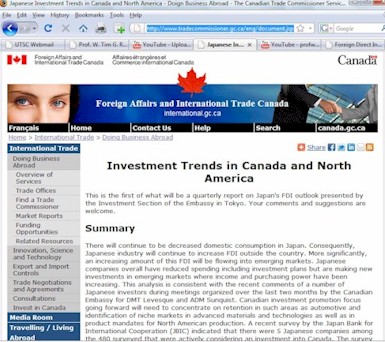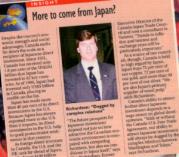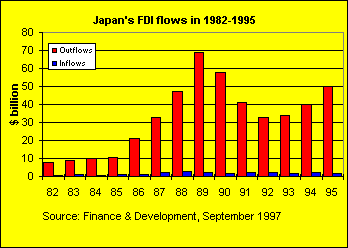
| JAPANESE |
 |
| >>>> | .
|
 |
Feb 27th 2011, student Sung
Jung K. in MGTC46 at UTSC emailed to comment
"I have been reading Japanese Investment Trends in Canada from http://www.tradecommissioner. I have some concerns. According
to a a recent survey by the Japan Bank for International
|
| Investment
Trends |
Sung Jung K.
adds
The
JBIC Study entitled "Outlook for Japanese Foreign Direct Investment
Also,
more and more Japanese companies were considering to invest their FDI
Sincerely, Sung Jung K. " WTGR answers
|
| CDA-JPN
Business NIKA Shigoto CDA-JPN
|
.
Source: Trade
Data Online. Industry Canada as quoted on the Asia Pacific Foundation website
www.asiapacificbusiness.ca/stats/trade/general_dataset1_japan.cfm
|
|||||||||||||||||||||
| JAPANESE
FDI
|
Some of the key reasons why Japanese FDI in Canada never approached 10% of Japanese FDI in the U.S.A.
eg. the Japanese cut the tariff they had on importing soybean oil into Japan from the USA, but did not cut the tariff they had on importing canola oil into Japan from Canada - this allowed American farmers a competitive advantage |
| DOBSON |
|
| Japanese
Government |
Canada-Japan
relations from the perspective of the Japanese government
"JAPAN AND CANADA IN A CHANGING ASIA" Speech By Takashi Koezuka, Minister, Embassy of Japan To The 1999 Far Horizons Conference, Queen's University, March 6, 1999 http://www.embassyjapancanada.org/JapanCanadaRelations/Speeches/koezuka1.html Koezuka-sans speech is great to read because it contains a good intro about how the Japanese bubble economy grew in the 1980's then burst, and how it is recovering. "Back in the late 1980's Japan's economy was booming. ...Japan was in what is now referred to as a "bubble economy". This bubble was inflated by high asset and land prices. Then the bubble economy burst....As the 1990's have progressed, however, it has become evident that the country's economic problems are more serious than was initially thought. " "Japan continues to struggle
with the aftermath of the bubble economy and especially with the lingering
bad debt problem. When real estate and share prices dropped, many borrowers
were no longer able to pay off their loans. This left the banks and other
financial institutions with large portfolios of non-performing loans. Japan's
economic woes have been compounded by a significant increase in bankruptcies
and a rise in the unemployment level. As a result of the bad loan problem
and capital depreciation, many banks have tightened their lending practices.
This has led to what is referred to as a "credit crunch."
|
| Canadian
Government on Japan Canadian
Canadian
|
Canada-Japan
relations from the perspective of the Canadian government.
http://www.infoexport.gc.ca/docs/view-e.asp?did=851&gid=22 "Japan is Canada's third
largest source of FDI after the US and UK. Total cumulative Japanese FDI
to Canada, on a notification basis, amounted to C$12 billion at the end
of FY1995 (March '96). Japanese investment in Canada is concentrated in
five sectors: forestry, the auto industry, mining, merchandise distribution
and financial and other services"
http://www.dfait-maeci.gc.ca/ni-ka/menu-e.asp http://www.dfait-maeci.gc.ca/ni-ka/overview/relations-e.asp
The BCNI (Business Council on National Issues) is a corporate membership based lobbying group based in Ottawa. On the BCNI website is an article written by Sam Boutziouvis which is somewhat critical of the Japanese FDI situation and it is worth looking at his writing.
"After decades of relative
success in a rather comfortable, complementary relationship, our trade
and investment patterns essentially have become stagnant. The
value of bilateral trade flows over the past decade has grown very little,
especially when compared with our overall trade picture. Bilateral investment
flows have increased, but remain at low levels. Despite growth in the knowledge-based
economy, the mix of products being traded has changed only
marginally over the past decade."
Canadian government contacts re: Japan http://www.dfait-maeci.gc.ca/ni-ka/contacts/menu-e.asp |
| New
Japanese
FDI in Canada  |
Mitsubishi Gears for Entry into Canadian Vehicle Market, Selects First Dealers "Japan's Mitsubishi Motors has selected 31 dealers across Canada as the company prepares its autumn [2002] entry into the Canadian vehicle market. Three dealers were selected in BC, four in the Prairies, seven in Quebec, two in the Atlantic provinces, and 15 in Ontario. Mitsubishi hopes to initially sell 20,000 vehicles a year, or about 1.3% of the Canadian vehicle market. In the next five years, Mitsubishi intends to capture 2% of the market, requiring up to 150 dealerships across the country. Mitsubishi intends to target younger drivers, who make up 40% of the company's US sales." Information summarized from National Post. Japanís Marubeni Corp.
and Four Partners Agree to Expansion of Aluminum Plant
Sapporo Bento Chain to
Open Store in Vancouver
|
| New
Canadian FDI in Japan |
1. Four Seasons Opens Hotel in Central Tokyo Oct 2002 "Four Seasons Hotels and Resorts will open its new 57-room luxury hotel in Tokyo tomorrow [2002 Oct 12]. Rates at the hotel, which is located near Tokyo Station, will be in the range of C$633 per night. Four Seasons has one other hotel in Tokyo - the 280-room Chinzan-So hotel. The company is also considering opening a business resort within 300km of Tokyo." Information summarized from Nikkei Ryutsu Shimbun. Release by the Asia Pacific Foundation of Canada 2. Ivanhoe Energy Creates
New Subsidiary in Japan Nov 2002
|
| . |  |
In 1989 a large mission
of senior Japanese executives came to Canada for a coast-to-coast trip
that was quite significant for the subsequent direction of Japanese FDI
in Canada in the 1990's.
In 1991, when Japanese FDI was still hot, Prof. Richardson, who was working on Bay Street at the time, was interviewed in TIME magazine in a special report on Japanese investment |
| . |  |
Here is a scan of the section of the article featuring the comments by Richardson - the essential points are related to Canada-Japan relations being effected by Japan's relationship with the U.S. |
